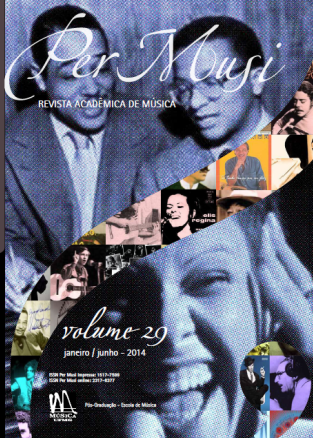Considerações sobre a análise de Grundgestalt aplicada à música popular
Palavras-chave:
Grundgestalt e variação progressiva, Música popular, Análise derivativaResumo
Este artigo discute a adequação do emprego de ferramentas analíticas associadas à teoria da Grundgestalt de Schoenberg para o exame de relações estruturais em peças de música popular. Após a apresentação dos conceitos básicos, são examinadas algumas conclusões presentes em um artigo pioneiro de GREEN (2008) sobre o tratamento motívico de Duke Ellington. Em seguida, as canções Chovendo na Roseira, de Tom Jobim e Something, de George Harrison são analisadas com o uso de metodologia específica desenvolvida pela pesquisa à qual está associado este estudo. Os resultados obtidos sugerem que, embora limitada a condições especiais e com as devidas adaptações, é perfeitamente possível a aplicação de análise derivativa em peças de música popular.
Referências
ALMADA, Carlos de L. Aplicações composicionais de um modelo analítico para variação progressiva e Grundgestalt. Opus, Porto Alegre, vol.18, nº 1, p.127-152, jun., 2012a.
_______________. Um modelo analítico para variação progressiva e Grundgestalt. In: XXII ENCONTRO ANUAL DA ANPPOM, 2012. João Pessoa. Anais ... João Pessoa: UFRN, 2012b.
_______________. A estrutura derivativa e suas contribuições para a análise e para a composição musical. In: Encontro de Musicologia de Ribeirão Preto, IV, 2012, Ribeirão Preto. Anais... Ribeirão Preto: EDUSP, p.205-214, 2012c.
_______________. Correlações entre estrutura musical e narrativa poética em Carinhoso. Revista Brasileira de Estudos da Canção, Natal, v.1, n.1, 2012d.
_______________. A Ursatz jobiniana: Considerações sobre aplicações da análise schenkeriana em estudos de música popular. In: 3er Congreso Latinoamericano de Formación Académica en la Música Popular. Villa María. Anais ... Villa María: UNVM, 2011a. 1 CD-ROM (10 p.).
_______________. Derivação temática a partir da Grundgestalt da Sonata para Piano op.1, de Alban Berg. In: II Encontro Internacional de Teoria e Análise Musical. Anais ...São Paulo: UNESP-USP-UNICAMP, 2011b. 1 CD-ROM (11 p.).
_______________. A variação progressiva aplicada na geração de ideias temáticas. In: II Simpósio Internacional de Musicologia. Rio de Janeiro: UFRJ, 2011c (no prelo).
_______________. Chovendo na roseira de Tom Jobim: Uma abordagem schenkeriana. Per Musi – Revista Acadêmica de Música, Belo Horizonte, n.22, 2010, p.99-106.
BOSS, Jack. Schoenberg’s Op. 22 radio talk and developing variation in atonal music. Music Theory Spectrum, v.14, n.2, 1992, p.125-149.
BURTS, Devon. An application of the grundgestalt concept to the First and Second Sonatas for Clarinet and Piano, Op. 120, no. 1 & no. 2, by Johannes Brahms. 2004. Dissertação (Mestrado em Música) – University of South Florida.
CARPENTER, Patricia. Grundgestalt as tonal function. Music Theory Spectrum, v.5, 1983, p.15-38.
DUDEQUE, Norton. Music theory and analysis in the writings of Arnold Schoenberg (1874-1951). Aldershot: Ashgate Publishings, 2005.
_______________. Variação progressiva como um processo gradual no primeiro movimento do Quarteto A Dissonância, K. 465, de Mozart. PerMusi – Revista Acadêmica de Música, Belo Horizonte, v.8, 2003, p.41-56.
EMBRY, Jessica. The role of organicism in the original and revised versions of Brahms’s Piano Trio In B Major, Op. 8, Mvt. I: A comparison by means of Grundgestalt analysis. 2007. Dissertação (Mestrado em Música) – University of Massachusetts Amherst.
EPSTEIN, David. Beyond Orpheus: Studies in music structure. Cambridge: The MIT Press, 1980.
FRISCH, Walter. Brahms and the principle of developing variation. Los Angeles: University of California Press, 1984.
GILBERT, Steven E. Gershwin ́s art of counterpoint. Musical Quaterly, n.70/4, 1984, p.423-56.
GREEN, Edward. ‘‘It don’t mean a thing if it ain’t got that Grundgestalt!’’— Ellington from a motivic perspective. Jazz Perspectives, v.2, n.2, 2008, p.215–49.
HAIMO, Ethan. Developing variation and Schoenberg’s serial music. Musical Analysis, v.16, n.3, 1997, p.349-65.
MARTINEZ, Alejandro. La forma-oración en obras de la Segunda Escuela de Viena: un lectura desde la morfología de Goethe. Revista del Instituto Superior de Música, Santa Fe, n.12, 2009, p.96-113.
MEYER, Leonard. Style and music. Chicago: The University of Chicago Press, 1989.
RAHN, John. Basic atonal theory. Nova Iorque: Longman, 1980.
SCHOENBERG, Arnold. Style and idea: selected writings of Arnold Schoenberg. (Leonard Stein, ed.). Londres: Faber & Faber, 1984
Downloads
Publicado
Edição
Seção
Licença

Este trabalho está licenciado sob uma licença Creative Commons Attribution 4.0 International License.

Exceto onde está indicado, o conteúdo neste site está sob uma Licença Creative Commons - Atribuição 4.0 Internacional.












